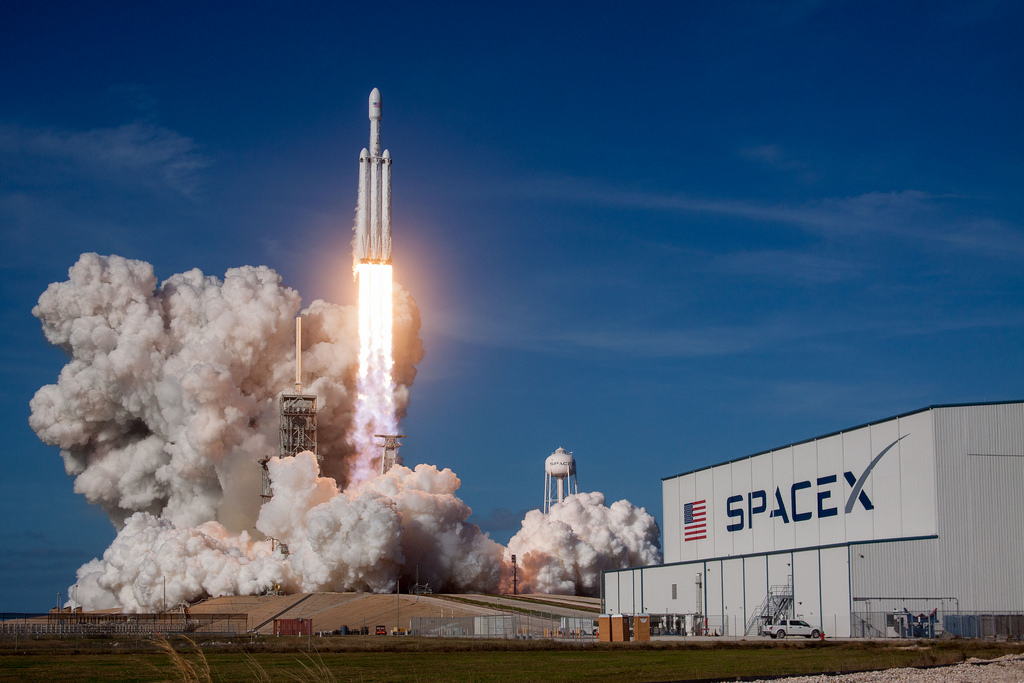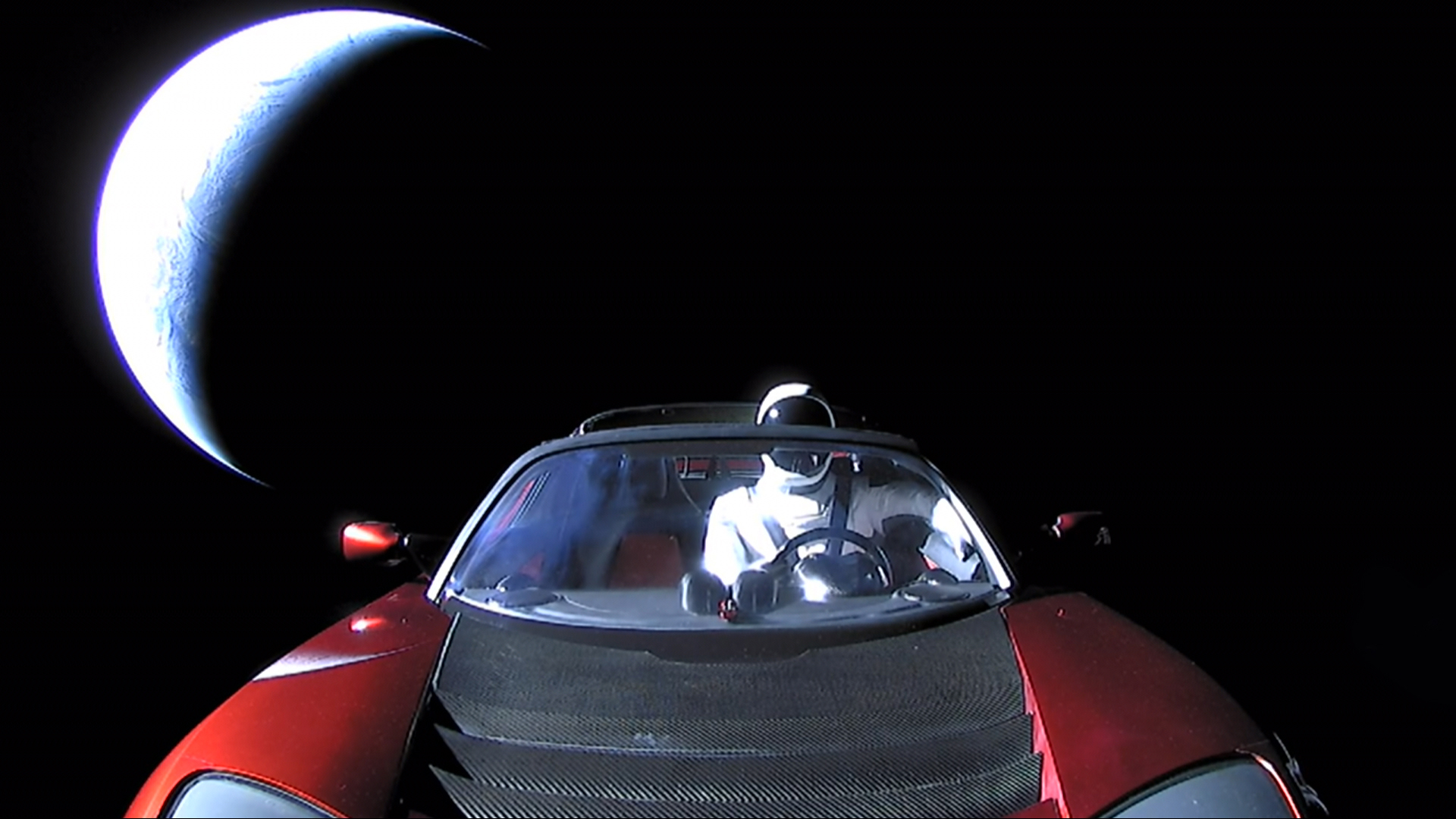Facts About SpaceX's Falcon Heavy Rocket

The Falcon Heavy is a large cargo-lifting rocket developed by private spaceflight company SpaceX. When it launched on its maiden voyage on Feb. 6, 2018, the rocket was the most powerful booster in operation at that time. (The Saturn V, which launched the Apollo moon missions, was the most powerful ever.)
On that debut test flight, the Falcon Heavy met almost all of its major objectives, including (notably) flying company founder and CEO Elon Musk's Tesla Roadster, carrying a mannequin named "Starman," to space.
More flights are planned for later in 2018 as the company begins to seek out more customers for the Falcon Heavy. Eventually, perhaps by 2020, Musk plans to use the experience in developing the Falcon Heavy to make an even bigger rocket, named the Big Falcon Rocket (BFR), for Mars exploration.
- Related: SpaceX's Falcon Heavy: Latest News, Images and Video
- In Photos: SpaceX's 1st Falcon Heavy Rocket Test Launch Success!
Brief development history
SpaceX was founded in 2002, backed by Musk, who previously co-created and sold the companies Zip2 and PayPal. After successfully developing and flying the Falcon 1 rocket, SpaceX received funding from NASA to develop a spacecraft — the Dragon capsule — that, in 2012, became the first commercial (nongovernment) spacecraft to bring cargo to the International Space Station. To get to space, the Dragon required a heavier-lift rocket called the Falcon 9, which SpaceX developed and then first flew in 2010.
Musk first announced a bigger rocket — the Falcon Heavy — in 2011. At the time, he said the rocket would carry 117,000 lbs. (53,000 kilograms) of cargo to orbit — twice the capacity of the space shuttle. Musk also predicted the first Falcon Heavy flight would come in 2013.
As is common in spaceflight, however, that date was pushed back several years during development. There were two catastrophic failures of the Falcon 9 rocket, in 2015 and 2016. Flights were suspended both times while the cause of the failures was investigated, and that likely contributed to pushing back the timeline of the Falcon Heavy.
SpaceX completed a static-fire test of the Falcon Heavy center core in May 2017. By September of that year, all three boosters planned for the first flight completed static testing.
Breaking space news, the latest updates on rocket launches, skywatching events and more!
Rocket specs
According to SpaceX's website, the Falcon Heavy is 230 feet tall (70 meters) and can lift nearly 141,000 lbs. (64 metric tons) of payload to low Earth orbit — about twice the payload capacity of its closest competitor, United Launch Alliance's Delta IV Heavy.
The rocket has two stages. The first stage has three engine cores. The center core is flanked and supported by two boosters. Each core is equivalent to the first stage of a Falcon 9 rocket and houses nine engines. The boosters separate after liftoff and land upright back on Earth, possibly to be used again. Meanwhile, the heavier center core aims for a drone ship, carrying its payload in the second stage.
The 27 engines on the first stage of Falcon Heavy, working together, are capable of more than 5 million pounds force (22,819 kilonewtons) of thrust at liftoff — the same force as about 18 747 aircraft at full power.
Maiden flight and next planned steps
The Falcon Heavy rocket lifted off for the first time on Feb. 6, 2018, from Kennedy Space Center (KSC) in Cape Canaveral, Florida, using Launch Complex 39A, the pad that used to host moon-bound Apollo astronauts and space shuttle crews. An estimated 100,000 spectators crowded the area's beaches and roadways to watch the rocket launch. Millions more watched a livestream showing the launch and events afterward.
During the launch, two boosters separated from the Falcon Heavy and landed at SpaceX landing sites at Cape Canaveral Air Force Station near KSC. The core stage was supposed to touch down on a drone ship dubbed "Of Course I Still Love You," but instead, it hit the Atlantic Ocean at 300 mph (480 km/h). The livestream continued for more than 4 hours after launch, showing the rocket's payload: a red Tesla Roadster and a spacesuited mannequin called "Starman." The Falcon Heavy then fired its engines to put it in an orbit around the sun that could extend past Mars. (The car itself might rip apart due to radiation in a year, Space.com sister site Live Science reported.)
SpaceX plans to follow up its launch with two Falcon Heavy missions in 2018. The first will launch the Arabsat 6A communications satellite. The second will launch Space Test Program 2 into orbit for the U.S. Air Force, along with a solar-sail mission for The Planetary Society. The company will sell Falcon Heavy launches for about $90 million per flight, compared with the $62 million SpaceX charges for single-core Falcon 9 launches. Over time, SpaceX plans to reduce the cost of Falcon Heavy launches because of their reusable boosters. If SpaceX wants to target the lucrative military launch market, for example, certification will take between two and 14 successful launches, a SpaceX spokesperson told SpaceNews in early February 2018.
Meanwhile, SpaceX continues cargo flights to the International Space Station with its Dragon spacecraft. A human-rated version of Dragon — called the Crew Dragon — is also under development, and the first test flight for that spacecraft is anticipated to occur in late 2018. [Related: SpaceX Launched the World's Most Powerful Rocket. So What's Next?]
In the coming years, SpaceX plans to develop the Big Falcon Rocket (BFR), a system that would dwarf the Falcon Heavy. According to Musk, BFR could be used to bring hundreds of passengers at a time to different destinations around the world, and on to Mars; in September 2017, Musk delivered an updated version of his ongoing Mars colonization plans that would include use of the BFR. Musk has said that the BFR will likely replace the Falcon Heavy and Falcon 9 rockets during the 2020s.
Additional resources
- SpaceX: Learn more about Falcon Heavy, Falcon 9, Dragon and more at the company's website.
- Read NASA's account of Falcon Heavy's successful launch.

Elizabeth Howell (she/her), Ph.D., was a staff writer in the spaceflight channel between 2022 and 2024 specializing in Canadian space news. She was contributing writer for Space.com for 10 years from 2012 to 2024. Elizabeth's reporting includes multiple exclusives with the White House, leading world coverage about a lost-and-found space tomato on the International Space Station, witnessing five human spaceflight launches on two continents, flying parabolic, working inside a spacesuit, and participating in a simulated Mars mission. Her latest book, "Why Am I Taller?" (ECW Press, 2022) is co-written with astronaut Dave Williams.


